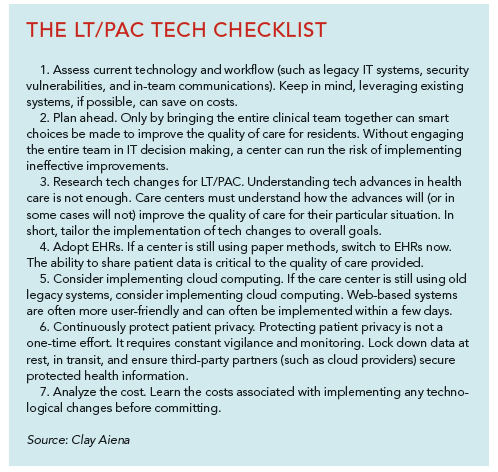The Digitally Efficient Care Center
Staying ahead of technological changes and carefully weighing options can lead to gains in quality care.
Clay Aiena
1/1/2018
While the rapid changes in technology have made a significant impact on health care, long term and post-acute care (LT/PAC) providers must plan ahead to make sure they get the most out of technological advances. They must first and foremost plan for changes that best serve residents and staff; however, proper planning requires a thorough understanding of the ways tech is transforming senior living and care options. The time to start is now. It’s no secret America is aging. By 2050, U.S. citizens 65 and older will surge to 83.7 million, is double today’s numbers, according to the U.S. Census Bureau. Current estimates show 44 percent of men and 58 percent of women will require long term care in their lifetime.
Tech Transforming Care
The first step in implementing technological changes is understanding the center’s current information technology (IT) infrastructure. This includes addressing legacy IT systems (older computers and operating systems that have insufficient network bandwidth and lack WiFi coverage, for example), security vulnerabilities, and in-team communications.
It is also important to understand the current workflow. Without this understanding, mistakes and ineffective technological changes could be implemented, often resulting in reduced quality of care and increased costs.
One change in LT/PAC can be found in the utilization of Internet of Things (IoT)-based remote health monitoring systems. Within a hospital setting, every vital sign can be monitored; however, when a patient is discharged, the ability to continue to monitor her signs becomes limited. By implementing IoT-based remote health monitoring systems, LT/PAC providers can receive vital information about a patient’s condition in real time and can act quickly to reduce hospitalizations and readmission rates.
Interesting technology in this space includes under-mattress sensors, smart “watches” with health applications, and flexible temperature-monitoring patches, to name a few. They can be deployed both in an LT/PAC center and in the home, automatically sending data wirelessly to health care providers for trending and urgent alerting.
Other changes include “e-visits” that allow patients to phone or videostream visits with health care providers to save time and lower costs. Further, providers can utilize electronic health records (EHRs) to promote preventive care, family involvement, and improved care transitions. LT/PAC providers can leverage EHRs to improve senior care by sharing data through Health Information Exchanges, pharmacies, rehabilitation centers, and so on.
Cloud Computing: Looking Forward
The use of cloud computing (most delivered as SaaS—software as service) is becoming more of the norm in health care facilities. Adopting private, public, or hybrid cloud computing allows providers to access cloud-based applications from any internet-enabled device. This allows LT/PAC providers to access health care information at the times when they need it most.
In addition to improving patient care, cloud computing can often lower operational costs by replacing legacy IT systems.

Once implemented, cloud computing eliminates the expensive need for servers, hardware, and other costly supporting infrastructure.
Choose a cloud solution carefully. While many companies offer customizable services, most LT/PAC centers will be just fine with the standard solution offered. If a center needs customization, make it a rare occurrence as it is more expensive to implement and carries significantly higher costs down the road.
Guarding Patient Privacy
Because of cloud computing and other technological advances in health care, patient privacy continues to be a top priority.
To effectively protect patient privacy and security, health care providers need to perform periodic risk assessments, encrypt all portable devices, ensure staff security awareness, and monitor vulnerabilities to protect high-value patient information. Always make sure to lock down data at rest and in transit and ensure the care center’s cloud providers secure protected health information.
The Financial Impact
Before implementing technological changes in a care center, perform a financial risk assessment. In short, make sure the cost is worth the benefit. By researching options, a center can help keep unwanted cost from rising. Some technological advances come with steep implementation fees, ongoing maintenance, and training fees. Only by understanding all the associated costs will a center find the right solution.
Fortunately, cloud-based technology tends to be a safe option. By moving costly in-house technology to cloud-based solutions, a center will often save money while improving efficiency. Also, keep in mind technological changes are fluid and always changing.
Health care professionals and consumers need to be aware of how these changes can improve the quality of life in the senior care profession. With more and more Americans aging, the market for senior and longevity care is booming. According to Oxford Economics, the health care needs for Americans over 50 is expected to reach $7.1 trillion (46 percent of the U.S. economy).
While the changes in health care and tech are exciting, it’s important to make the right decision for the nursing center. Define the company’s goals and objectives, meet with the team, and implement only those technological advances that will make goals and objectives a reality. Only then will a center more fully realize the quality of care residents deserve.
Clay Aiena is chief information officer for StoneGate Senior Living, an award-winning full-spectrum senior care and housing company. He has extensive experience in the health care and medical device industry, driving technology strategy for both health care professionals and providers. He can be reached at: 972-899-7100 or via LinkedIn at www.linkedin.com/in/clayaiena.